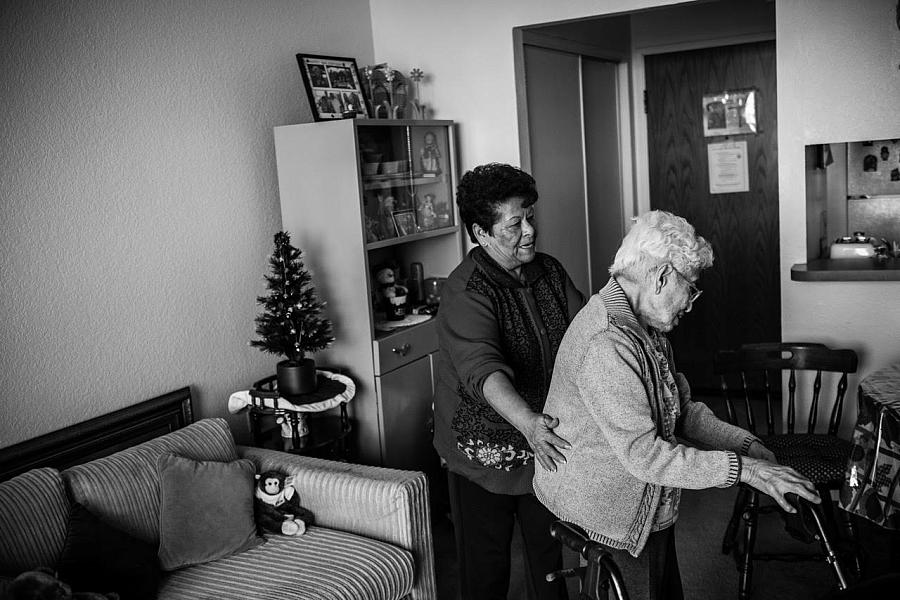For seniors, caregivers keep a dangerous health condition at bay — loneliness

Maria Martínez helps her client, Agripina Castellanos, as she walks inside her Angelus Plaza apartment. (Photo by Bear Guerra)
In the middle of downtown Los Angeles stands Angelus Plaza, a cluster of high rises where more than 1,400 seniors live. It is the country’s largest affordable senior housing complex, but it is not a nursing home: Residents live alone in apartments equipped with kitchens, and are free to come and go as they please.
But many residents, like 99-year-old Mexico native Agripina Castellanos, do rely on professional caregivers to help them live independently. Castellanos is in great physical health: She takes no medications and suffers from no chronic health conditions. But she needs help cooking, cleaning and paying her bills. She could use some assistance in the shower, and, increasingly, getting dressed. Until recently, Castellanos used to be able to tie her own shoes, but now her caregiver Maria Martínez must help her with those, too.
For the past decade, Martínez has been by Castellanos’ side for eight hours a day, five days a week. When Martínez’s husband passed away two years ago, she found it hard emotionally to stay at home alone. So she decided to increase her hours, and now she’s at Angelus Plaza every day of the week.
“Every single day she’s at home with me,” said Castellanos when we met last fall, while a telenovela played on her living room TV set. “She goes home when her shift is due, but I am always confident that I’ll see her the next day, even if she’s late.”
Martínez, 65, may as well be Castellanos’ daughter: The two of them have grown close over the years. As a professional caregiver, Martínez makes $11 an hour — that’s $4 less than the minimum wage in Los Angeles. It’s barely a livable wage, and she knows it. But the work affords her a new sense of purpose. They’re each other’s confidantes and companions.
By 2050, an estimated 88.5 million people in the U.S. will be over 65 years of age or older; 42 percent of all seniors will be people of color. This will represent an exponential hike in the senior population — more than double what it was in 2010.
Researchers say that older adults are at an increased risk of being lonely. By the time people reach their eighties, the majority of them live on their own and with fewer prospects of finding a community of like-minded people, or even of leaving the house without help.
On the other hand, in-home caregiving can have far-reaching benefits for seniors. According to a study from Brigham Young University, social isolation is just as likely to predict an early death as smoking 15 cigarettes a day. As a long-term risk factor, loneliness ranks alongside obesity and alcohol abuse.
The opposite is also true: Companionship can lead to better physical health and longer lives. It can fend off depression and chronic health conditions such as heart disease. Short of being cared for by a loving family member, the companionship of a caregiver of the same cultural, religious or racial background is important for most Asian, Hispanic and African-American seniors.
Among non-whites, caregiving — and being cared for — is typically seen as a part of life that is handled within the family and for no pay.
Of course, for those who are hired, it’s hard work that’s typically underpaid, in an industry with a high turnover rate. An estimated six out of 10 caregivers leave their jobs every year.
Martínez, however, told me she has no interest in retiring. Like her client, she too is in great health.
“I raised four children, and caring for an elder isn’t much different,” Martínez said. “Being a caregiver is part of my family. It’s part of my culture.”

